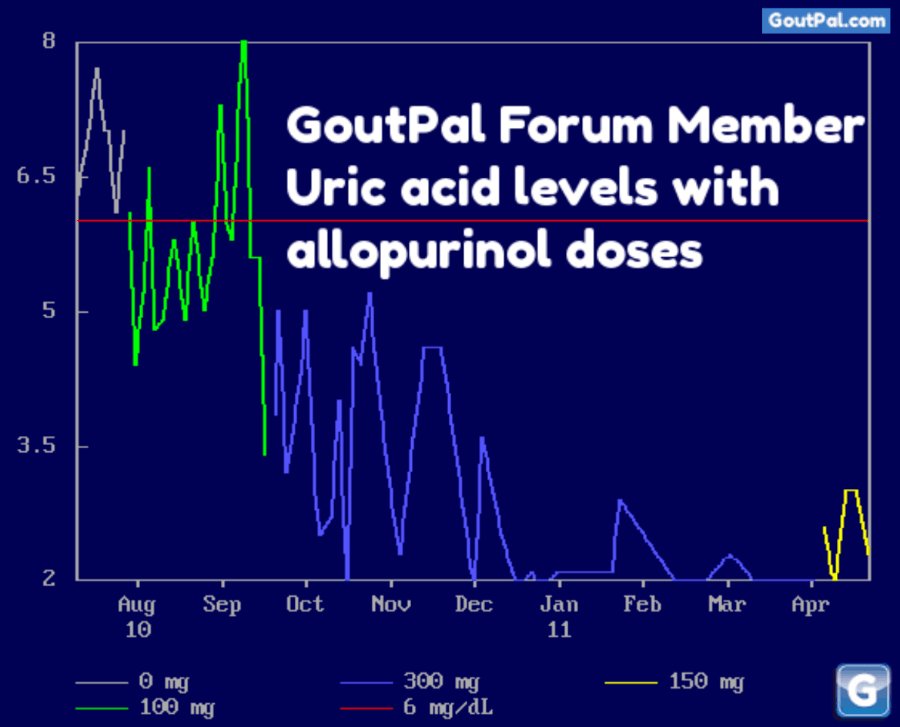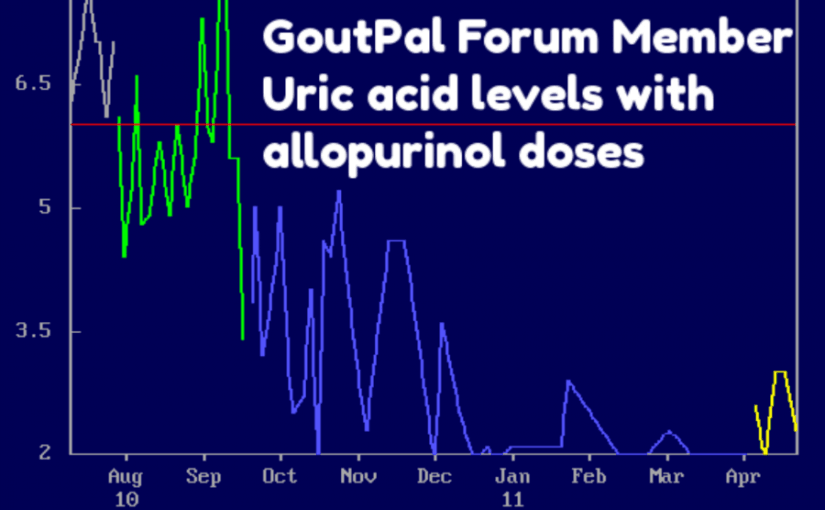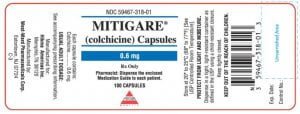Allopurinol gout treatment is the most common form of long-term gout treatment. It works by blocking the enzyme, xanthine oxidase, that normally produces uric acid. So it is vital that you have regular uric acid tests whilst on this treatment.
Allopurinol Gout Treatment Purpose
I wrote this explanation of allopurinol gout treatment several years ago. At the time, there were no professional guidelines for doctors. So I recommended the following procedure as a way for gout sufferers to frame the uric acid treatment discussion with their doctors. Now, all doctors treating gout should be aware of this procedure. But I’ve retained it because it remains useful for the patient-physician relationship during GoutPal Patients Plan.
This supports the Purpose of GoutPal.com. Because it helps gout sufferers discuss uric acid control with their doctors. So if you are not committed to such a uric acid treatment plan, you should start with Questions for Gout Sufferers. Otherwise, continue with this allopurinol treatment explanation. Or skip to related allopurinol treatment information below.
Allopurinol Gout Treatment
Before you begin taking allopurinol, you must be aware that all uric acid lowering therapies can trigger a painful gout flare. But this will diminish as you keep taking the medication. Because it is caused by uric acid crystals that have accumulated in your body tissue dissolving. So it is vital that you get rid of these crystals to avoid crippling joint damage. Therefore, you must manage this pain for the few weeks or months that it takes to dissolve them. See my explanation of allopurinol medication for more details.
You will normally start with 50 mg – 100 mg allopurinol tablets, followed by a blood test. But it is important to go straight back to your doctor if you notice any allopurinol side effects. Because in a very small number of cases, you can have a strong reaction against this drug. So it is vital that this is picked up immediately.
The blood test will indicate if your dosage needs to be increased. So a common allopurinol gout treatment dosage is 300 mg. But this will depend entirely on your particular circumstances. Then repeat blood tests at the interval advised by your doctor to ensure this dosage is right for you.
Although allopurinol gout treatment is common, it is also commonly misused. Because as I reported in my December 2006 Newsletter, less than half of gout patients who start allopurinol treatment continue with it. Of those that do, only one person in three will take a sufficient dose to lower uric acid to the level that will dissolve all uric acid crystals.
For successful allopurinol gout treatment, remember:
- Take pain relief as a precaution, or as you need it
- Continue to drink water all the time to flush oxypurinol from your system
- Get uric acid tests to make sure levels are maintained below 5 mg/dL (0.30mmol/L)
- Take allopurinol every day
- Do not stop taking allopurinol unless advised by your doctor

More Allopurinol Gout Treatment Information
There is in-depth information about all aspects of allopurinol gout treatment in the Gout Treatment Section. The information is spread over several pages starting on the allopurinol page within the uric acid lowering subsection.
Leave Allopurinol Gout Treatment to read more allopurinol information.
Allopurinol Gout Treatment Related Topics
Please remember: to find more related pages that are relevant to you, use the search box near the top of every page.
Common Terms: allopurinol
Other posts that include these terms:
- When To Start Allopurinol
- Gout Medications To Avoid Gout By Lower Uric Acid
- Starting Allopurinol – Dosing Guidelines
- What Is Allopurinol?
- Allopurinol And Alcohol: Can You Spirit Away Gout?
- Gout Pain Relief in 2 Hours
- Allopurinol Rash: Are You At Risk?
Allopurinol Gout Treatment Spelling
Like many medicines, allopurinol is often misspelled. Though spelling is often overrated, it pays to take extra care with medicines, as a misunderstanding might cause treatment problems in the unlikely event of a similar sounding drug being taken mistakenly.
Additionally, bad spelling or using brand names can make searching for information difficult.
I have now moved spelling tips to the allopurinol facts page. So see Allopurinol facts for allunopril, aloperinal, alu purinol, alupronol, alupurionol, and appurinol.
This article was first published prior to May 2008 and is reformatted here to suit the updated layout.
Please give your feedback
Did this page help you? If yes, please consider a small donation. Your donations help keep GoutPal's gout support services free for everyone.
If not, please tell me how I can improve it to help you more.
- YouTube
- The gout forums.










